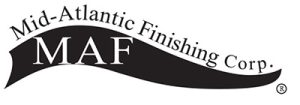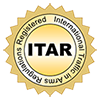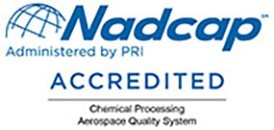GOLD PLATING SERVICES
NADCAP certified gold metal plating
Gold plating is a method of depositing a thin layer of gold onto the surface of another metal called a substrate by chemical or electrochemical plating process. Plating has been done for hundreds of years and is critical for todays’s technology. Gold plating is often used in electronics, to provide a corrosion-resistant electrically conductive layer.
Mid-Atlantic has been providing metal plating services for over 40 years to industries such as, aerospace, defense, RF and microwave communications sector and the medical field. Our longevity and dedication to quality assurance makes us your preferred metal plating services company.
GOLD PLATING SERVICES TO THE FOLLOWING STANDARDS:
Mid-Atlantic Finishing’s gold plating services conform to most specifications.
ASTM B488-01
NOTE: ASTM B488 underwent a major revision from 1995 to 2001. The Type callout of the ASTM was revised to parallel that of MIL-G-45204 such that the Type and Codes of the ASTM and MIL specs are synonymous.
Type I: 99.7% pure gold with a hardness ranging from A (90 HK25 max) to C (130-200 HK25).
Type II: 99.0% pure gold often referred to as hard gold with a hardness ranging from B (91-129 KH25) to D (> 200 HK25).
Type III: 99.9% pure gold often referred to as soft gold with a hardness of A only (90 HK25 Max).
Code A: 90 HK25 Maximum
Code B: 91-129 HK25
Code C: 130-200 HK25
Code D: > 200 HK25
Relationship Between Purity and Hardness (ASTM B488-01 and Newer)
Type I – Code A, B and C
Type II – Code B, C and D
Type III – Code A Only
Class Minimum | Thickness [um]
| 0.25 | 0.25 |
| 0.50 | 0.50 |
| 0.75 | 0.75 |
| 1.0 | 1.0 |
| 1.25 | 1.25 |
| 2.50 | 2.50 |
| 5.00 | 5.00 |
Nickel Underplating – For thickness classes except 5.0, a nickel underplating shall be applied before the gold coating when the product is made from copper or copper alloy. Nickel Underplating is also applied for other reasons indicated below.
Reasons for Using a Nickel Underplate
- Diffusion Barrier (E.g. migration of zinc into the gold layer from a brass substrate)
- Leveling Layer (Brightening)
- Pore Corrosion Inhibitor
- Tarnish Creepage Inhibitor for Gold
- Load-Bearing Underlayer for Contacting Surfaces
MIL-G-45204
Type I: 99.7 percent gold minimum
Type II: 99.0 percent gold minimum
Type III: 99.9 percent gold minimum
Grade A: Knoop hardness 90 max
Grade B: Knoop hardness 91-129, incl.
Grade C: Knoop hardness 130-200, incl.
Grade D: Knoop hardness 201 and over.
If the hardness grade for the gold coating is not specified, Type I shall be furnished at hardness Grade A (90 Knoop max) and Type II shall be furnished at hardness Grade C (130 to 200 Knoop)
| PURITY | HARDNESS |
| Type I | A, B, or C |
| Type II | B, C or D |
| Type II | A Only |
Class 00 – 0.00002 inch thick, minimum
Class 0 – 0.00003 inch thick, minimum
Class 1 – 0.00005 inch thick, minimum
Class 2 – 0.00010 inch thick, minimum
Class 3 – 0.00020 inch thick, minimum
Class 4 – 0.00030 inch thick, minimum
Class 5 – 0.00050 inch thick, minimum
Class 6 – 0.00150 inch thick, minimum
AMS 2422
Copper Flash or Copper Strike: A copper flash or copper strike shall be electro-deposited from a suitable plating solution, except as exempted below.
When parts to be plated are made of copper or copper alloy containing less than 15% zinc, the copper flash or copper strike may be omitted.
Nickel Flash or Nickel Strike: A nickel flash or nickel strike shall be electro-deposited from a suitable nickel plating solution over the copper, copper alloy containing less than 15% zinc, copper flash or copper strike as applicable.
Copper Flash or Strike: Not less than 0.0001 inch (2.5um)
Nickel Strike: Not less than 0.0001 inch (2.5um)
Gold Plate: Note less than 0.00005 inch (1.27um) on all surfaces on which gold plating is specified.
Purity: Gold, as plated, shall be not less than 99.0% pure, determined by a method acceptable to purchaser.
Proactive Personalized Service
Prompt Quotes. Fast Turnaround Times
Suberb Qualilty, Value-Added Results
Competitive Pricing
PERFORMANCE BENEFITS
ITEMS OF NOTE
Unless otherwise specified, an intermediate nickel plate is required on copper base alloys or copper plated surfaces prior to the gold plating.
The final product will be yellow to orange in color depending on proprietary process used.
A semi-bright finish maybe applied depending on basis metal.
PRECISION METAL PLATING TO EXACT SPECIFICATIONS
MAF Corp. is NADCAP approved for chemical processing by PRI International.
REQUEST A QUOTE
Precision metal plating services for aerospace, defense, medical and RF & Microwave sectors.








